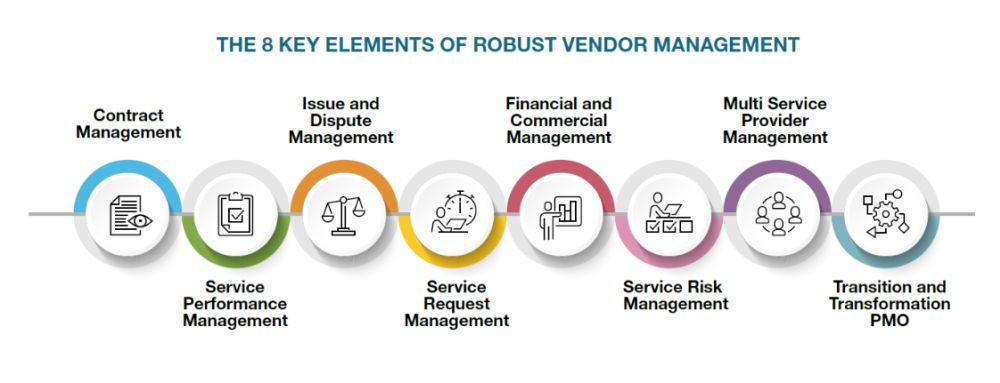- within Criminal Law, Law Practice Management, Litigation and Mediation & Arbitration topic(s)
The role of vendor management is to manage effective service delivery, minimize risk, drive cost savings and, overall, improve the services that are provided through outsourced contracts. While the discipline of vendor management as part of an overall governance framework has been around for a number of years, deployment is often immature. With today's new services, tools and technologies, the opportunity to realize value from a comprehensive approach to vendor management has never been greater. Moreover, alternative approaches to vendor management are possible, including scenarios in which an expert provides vendor management as a service for key relationships or an entire portfolio.
Historically, vendor management functions have been viewed as a control function focused on basic contract management of commercial arrangements. However, increasingly, best practice vendor management includes a broader range of activities and a heavy involvement in driving transformation and process improvement. This has especially been prevalent in organizations with operations in multiple geographies, where there are multiple service providers, and in industries in which there are active regulatory considerations.
Vendor management has expanded from a mere control function to a broader range of activities with heavy involvement in driving transformation and process improvement.

Many organizations claim to have broad vendor management capabilities, incorporating most, if not all, of the attributes shown in the chart above, but are they effective? Is the organization getting value? The basics of managing service delivery to the contract is typically done well enough, with reported service levels validated against the contract and invoices checked for accuracy per the contract. However, while this may sound good, it is no guarantee of management satisfaction or even alignment of delivery with the ambition of company leadership. This is especially true in today's dynamic environment, with progressive opportunities to integrate technology into the delivery model.
The contrast to the basics, as described above, is a vendor management team that becomes a constant driver of innovation, focused on creating value for the organization. Value may be manifested in various ways, such as:
- Driving higher output for lower cost
- Dynamically repurposing the existing spend to be laser focused on delivering to management goals
- Automating delivery models to increase speed to value and reduce error rates
- Aligning internal and external activity balance
- Overall reduction in risk across a program
This should be accompanied by real time "dashboard" reporting, with deep analytics to enable more effective management decision-making.
Leading organizations with outsourced service delivery are proactive in managing their vendor(s) and look to progressive transformation of the delivery model. This requires extensive liaison with internal stakeholders to define and work through potential areas of improvement. Such liaising is often, but not always, suggested by the service provider. Improvements may be focused on more rapid service delivery, improved accuracy, lower cost or reduced risk
Recent developments in automation, and especially artificial intelligence, are providing many opportunities for process improvement. However, while this sounds simple, a key role of an effective vendor management organization is to develop a plan to design and implement such improvements, including contract and pricing amendments, on behalf of the buyer. Such a plan typically addresses preconditions for automation, such as process standardization, introduction of new technology, training of staff at the service provider and the customer, new reporting, and risk mitigation procedures.
It is likely that the vendor management lead will need to establish and deploy strong ideation and collaboration tools to identify, drive and realize the value that these opportunities should create. Furthermore, this is an excellent opportunity to drive creative commercial models, such as gain sharing or value pricing, which incentivize the service provider to put "skin in the game," in return for a measurable outcome. We have previously published an article1 discussing different approaches to pricing, and as the progression is moving beyond input or output pricing and toward outcome-based approaches, there will be a necessity for rigorous involvement and monitoring through effective vendor management.
Obtaining business value from effective governance means changing the paradigm of vendor management as a control function to be something else: to be a catalyst for change and to capture value from innovation. We at A&M think that this can be achieved now — the technology, tools and techniques are available. Will executive management take the leap and expect more from vendor management? The time for action is now!
Footnote
1 Brian Smith and Simon Tarsh, "Artificial Intelligence is Making Risk-Sharing Charging Mechanisms a New Normal," March 6, 2024, Alvarez & Marsal, https://www.alvarezandmarsal.com/sites/default/files/article/pdf/437782_CPI-DTS_GBS AICharging Mechanisms TL_02.pdf
Originally published 22 October 2024
The content of this article is intended to provide a general guide to the subject matter. Specialist advice should be sought about your specific circumstances.



